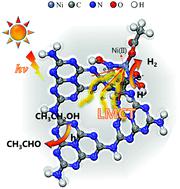当前位置:
X-MOL 学术
›
Chem. Commun.
›
论文详情
Our official English website, www.x-mol.net, welcomes your
feedback! (Note: you will need to create a separate account there.)
A new Ni-diaminoglyoxime-g-C3N4 complex towards efficient photocatalytic ethanol splitting via a ligand-to-metal charge transfer (LMCT) mechanism.
Chemical Communications ( IF 4.3 ) Pub Date : 2020-05-19 , DOI: 10.1039/d0cc01120g Yanqi Xu 1 , Cui Du , Chen Zhou , Shengyang Yang
Chemical Communications ( IF 4.3 ) Pub Date : 2020-05-19 , DOI: 10.1039/d0cc01120g Yanqi Xu 1 , Cui Du , Chen Zhou , Shengyang Yang
Affiliation

|
We report a novel Ni–diaminoglyoxime–g-C3N4 (Ni–DAG–CN) complex for H2 evolution through photocatalytic ethanol splitting. Compared to that of pristine g-C3N4, Ni–DAG–CN exhibits a 21-fold enhancement of photocatalytic activity (296.1 μmol h−1 g−1) under irradiation with excellent stability. The enhanced photocatalytic activity can be attributed to a proposed ligand-to-metal charge transfer (LMCT) mechanism, which is illustrated both experimentally and theoretically. This work provides great potential in the future design of low-cost, high-performance photocatalysts for H2 evolution from alcohol splitting.
中文翻译:

一种新的Ni-二氨基乙二肟-g-C3N4络合物,可通过配体-金属电荷转移(LMCT)机理实现有效的光催化乙醇裂解。
我们报告了通过光催化乙醇裂解产生H 2的新型Ni-二氨基乙二肟-gC 3 N 4(Ni-DAG-CN)复合物。与原始gC 3 N 4相比,Ni–DAG–CN在辐射下的光催化活性增强了21倍(296.1μmolh -1 g -1),具有出色的稳定性。增强的光催化活性可以归因于提议的配体到金属的电荷转移(LMCT)机理,该机理在实验和理论上均得到了说明。这项工作为将来设计低成本,高性能的光分解催化剂提供了巨大潜力,这些光催化剂可用于从酒精裂解中分离出H 2。
更新日期:2020-06-30
中文翻译:

一种新的Ni-二氨基乙二肟-g-C3N4络合物,可通过配体-金属电荷转移(LMCT)机理实现有效的光催化乙醇裂解。
我们报告了通过光催化乙醇裂解产生H 2的新型Ni-二氨基乙二肟-gC 3 N 4(Ni-DAG-CN)复合物。与原始gC 3 N 4相比,Ni–DAG–CN在辐射下的光催化活性增强了21倍(296.1μmolh -1 g -1),具有出色的稳定性。增强的光催化活性可以归因于提议的配体到金属的电荷转移(LMCT)机理,该机理在实验和理论上均得到了说明。这项工作为将来设计低成本,高性能的光分解催化剂提供了巨大潜力,这些光催化剂可用于从酒精裂解中分离出H 2。































 京公网安备 11010802027423号
京公网安备 11010802027423号